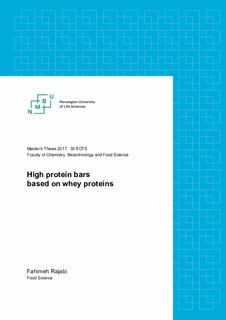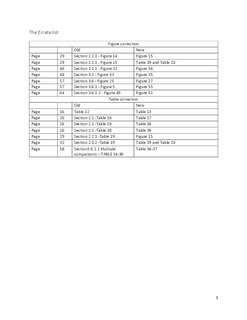| dc.description.abstract | The composition of a nutrient bar is based on the selection of the ingredients; proteins, carbohydrates, fats and natural sweeteners. In this study, a high protein bar with more than 30 % protein was produced and compared with existing low protein bars (20%) on the market. Such protein-rich bars are favored among health food enthusiasts and athletes.
This experiment was performed in two parts, in the first part (pre-experiment) a literature study of different types of bars on the market was done. Based on these results various ingredients were selected to produce five different high protein bars (approximately 30%) which was made by baking.
The major protein source was whey protein concentrate (WPC80) and cottage cheese, the carbohydrates (including starch) were from oat, sweet potato and quinoa the fat source was various vegetable oils including coconut oil and sesame oil and nuts. For the main experiment, two formulations were selected for producing the bars and two process technologies were applied; extrusion and baking. The formulation and methods for producing a high protein bar are critical for providing function, pleasant taste, texture, and product stability throughout the shelf-life. The main experiment comprised of two types of ingredients that varied mostly in starch composition, oat flakes (3.5%) and sweet potatoes (12.5%) both with quinoa. The formulation with oat flakes and quinoa was extruded, whereas the sweet potatoes and quinoa were baked in an oven. For extrusion, a twin-screw extruder was applied with processing conditions including low shear, high shear, and different moisture contents. The ingredients comprised of whey protein concentrate (37 %), cottage cheese (13.0 %,), roasted quinoa (7.0 %), oatmeal (10.0 %), coconut oil (3.0 %), sesame oil (0.5 %), sesame seed (0.5 %), sunflower seed (2.0 %), peanuts roasted (2.0 %), dried fruits (9.2 %), raisins (1.6 %), glycerin (7.0 %), stevia (4.0 %), honey (3.0 %), baking powder (0.1 %), flavors cinnamon-peanut (0.1 %) .
The extruded bars were analyzed for water content and water activity, hardness, expansion and density. These analyzes were performed immediately after extrusion and after drying and the results after extrusion showed that the expansion of the bars was lowest at low shear- low moisture conditions, however, at high shear- high moisture the best products were obtained (better expansion and less hardiness).
Baking was done in an oven at two temperatures; 50 °C and 100 °C and two cooking times; 10 min and 5 min. The ingredients comprised of whey protein concentrate (29.6 %,), cottage cheese (22.9 %), roasted quinoa (9.4 %), sweet potato (5.9 %), coconut oil (4.0 %), sesame oil (0.7 %), sesame seed (0.7 %), pumpkin seed (2.7 %), almonds (2.7 %), dried fruits (2.8 %), raisin (2.2 %), glycerin (9.4 %), stevia (2.7 %), honey (4.0 %), salt (0.13 %), baking powder (0.13 %), flavors-cinnamon-coconut (0.13 %).
A sensory analysis was made of extruded and baked protein bars, and these were compared with two commercial high protein bars. The results showed that the extruded bars (37 % protein content) did not have the desired taste and texture, although physical analysis of texture, expansion and cohesiveness showed acceptable results. Unlike extruded protein bars, the texture and taste of baked protein bars (29% protein content) was evaluated as better as compared with the two commercial products. This shows that the recipe must be changed if extrusion be used as a manufacturing method so that the product can satisfy consumer requirements | nb_NO |
| dc.description.abstract | Sammensetningen av ernæringsbars er basert på valg av ingrediensene; proteiner, karbohydrater, fett og naturlige søtningsmidler. I denne studien ble det produsert høy-proteinbars med mer enn 30 % protein. Disse ble sammenlignet med eksisterende lav-proteinbars (20 % protein) på markedet. Slike proteinbars benyttes av helsekost entusiaster og idrettsutøvere.
Dette forsøket ble utført i to deler. I første del (for-forsøket) ble det gjort en litteraturstudie av ulike typer bars på markedet. Med disse som utgangspunkt ble det valgt ut ulike ingredienser som ble benyttet til fem ulike bars med høyt proteininnhold (ca. 30 %) som ble laget ved steking. Som hovedproteinkilde ble myseproteinkonsentrat (WPC80) og cottage cheese benyttet, karbohydrater (inkludert stivelse) var fra havre, søt potet og quinoa, fettkilden var ulike vegetabilsk oljer, blant annet kokosolje og sesamolje og nøtter.
Til hoved-forsøket ble to av oppskriftene fra for-forsøket valgt til å produsere bars med to ulike prosesser; ekstrudering og baking. Både sammensetning av ingredienser og selve metoden for å produsere høy proteinbars er kritiske for funksjon, behagelig smak, tekstur og lagringsstabilitet av ferdig produkt. Oppskriftene som ble benyttet i hoved-forsøket besto av ulike ingredienser med stivelse fra ulike kilder; havregryn (3,5 %) og søtpoteter (12,5 %) begge med quinoa. Oppskriften med havregryn og quinoa ble ekstrudert, mens oppskriften med søtpotet og quinoa ble bakt i ovn.
Til ekstrudering ble en «tvilling-skrue» ekstruder benyttet, og effekt av ulike prosessbetingelser ble undersøkt; lav og høy skjærkraft og forskjellig vanninnhold. Ingrediensene bestod av myseproteinkonsentrat (37 %), cottage cheese (13,0 %), quinoa (7,0 %), havregryn (10,0 %), kokosnøttolje (3,0 %), sesamolje (0,5 %), sesam frø (0,5 %), solsikkefrø (2,0 %), peanøtter (2,0 %), tørket frukt (9,2 %), rosiner (1,6 %), glyserol (7,0 %), stevia (4,0 %), honning (3,0 %) , bakepulver (0,1 %), smak kanel-peanøtt (0,1 %). De ekstruderte bars ble analysert for vanninnhold og vannaktivitet , hardhet, ekspansjon og tetthet. Disse analysene ble utført umiddelbart etter ekstrudering og etter tørking, og resultatene viste at bars produsert ved kombinasjon av lav skjærkraft og lav mengde tilsatt vann var hardest, men kombinasjonen høy skjærkraft og høy vanntilsetning gav de beste produktene i form av bedre ekspansjon og mindre hardhet.
Baking ble gjort i en ovn ved to forskjellige temperaturer; 50 °C og 100 °C og to tider; x min og y min. Ingredienser bestod av myseprotein konsentrat (29,6 %), cottage cheese (22,9 %), quinoa (9,4 %), søtpotet (5,9 %), kokosolje (4,0 %), sesamolje (0,7 %), sesamfrø (0,7 %), gresskarfrø (2,7 %), mandler (2,7 %), tørket frukt (2,8 %), rosiner (2,2 %), glyserol (9,4%), stevia (2,7%), honning (4,0 %), salt (0,13%), bakepulver (0,13%), smak kanel-kokosnøtt (0,13%).
En sensorisk analyse ble gjort av ekstruderte og bakt proteinbars og disse ble sammenlignet med to kommersielle høy-proteinbars. Resultatene viste at de ekstruderte bars ( 37 % proteininnhold) ikke hadde ønsket smak og tekstur, selv om fysiske analyser av tekstur, ekspansjon og «kohesiveness» viste akseptable resultater. I motsetning til ekstruderte proteinbars, var tekstur og smak av bakte protein bars (29 % proteininnhold) vurdert som bedre sammenlignet med de to kommersielle produktene. Dette viser at oppskriften må endres dersom ekstrudering skal benyttes som fremstillingsmetode slik at produktet kan tilfredsstille forbrukerens krav. | nb_NO |


